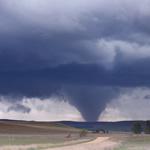Tornado, twister, hurricane, tropical cyclone, typhoon—what's the difference?
05 November 2015
Updated 18 September 2018
Always wanted to know your tropical cyclones from your typhoons? Your tornadoes from your twisters? It might be simpler than you think.
Tornadoes and twisters
Tornado and twister are different names for the same type of storm—a violently rotating column of air over land associated with a severe thunderstorm. Tornadoes range in diameter from metres to hundreds of metres and generally last from a few seconds up to half an hour. They have an intense updraught near their centre, capable of lifting heavy objects such as cars and trees and causing enormous damage.
Tornadoes are not uncommon in Australia. They typically occur in late spring and summer, but can also happen at other times of the year.
Tropical cyclones, hurricanes and typhoons
In Australia we call these large-scale storms tropical cyclones. In the USA they talk of hurricanes and in Asia, typhoons. Cyclones form over warm tropical waters where the sea's surface temperature is above 26° C. They are typically hundreds of kilometres in diameter and can last for many days, with maximum winds greater than 62 km/h, or for severe cyclones, greater than 118 km/h. Strong winds, heavy rain, flooding and storm surges can cause major damage.
The tropical cyclone season in northern Australia is normally between 1 November and 30 April, with most cyclones occurring from January to March. Hurricanes and typhoons typically develop at different times of the year. The Atlantic hurricane season runs from 1 June to 30 November, and the Eastern Pacific hurricane season runs from 15 May to 30 November. Most typhoons normally form from May to October, although they can occur year-round.
Similarly to cyclones in Australia, hurricanes are defined by a five category system based on maximum sustained wind speed. Typhoons are classified as “typhoon,” “very strong typhoon,” or “violent typhoon” by the Japan Meteorological Agency.
Learn more about tropical cyclone categories here
Video: Forecast Track Map for severe tropical cyclone Yasi.
More information
- Tropical cyclones
- Tropical cyclone warning services
- NOAA National Hurricane Centre
- Image at left: Strong tornado near the highway between Nimmitabel and Cooma, New South Wales, 2008. Photograph courtesy of Heather Leckie.




Comment. Tell us what you think of this article.
Share. Tell others.